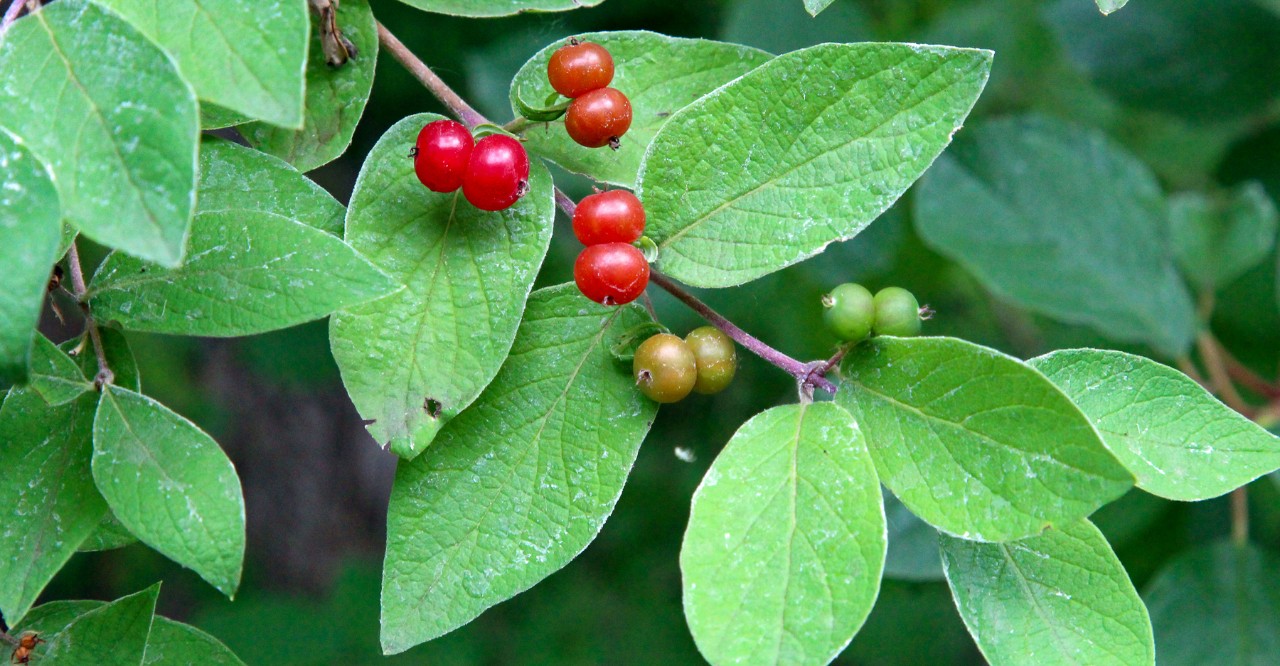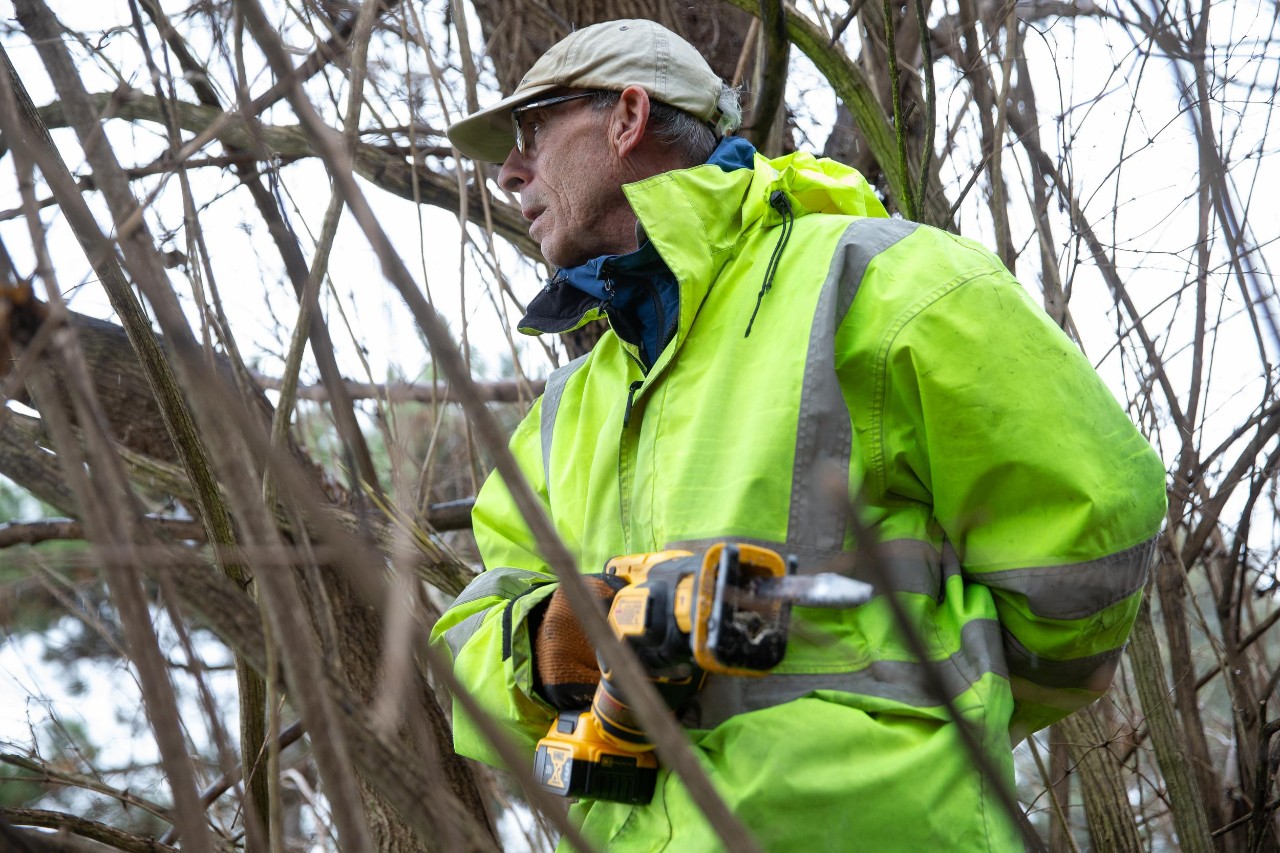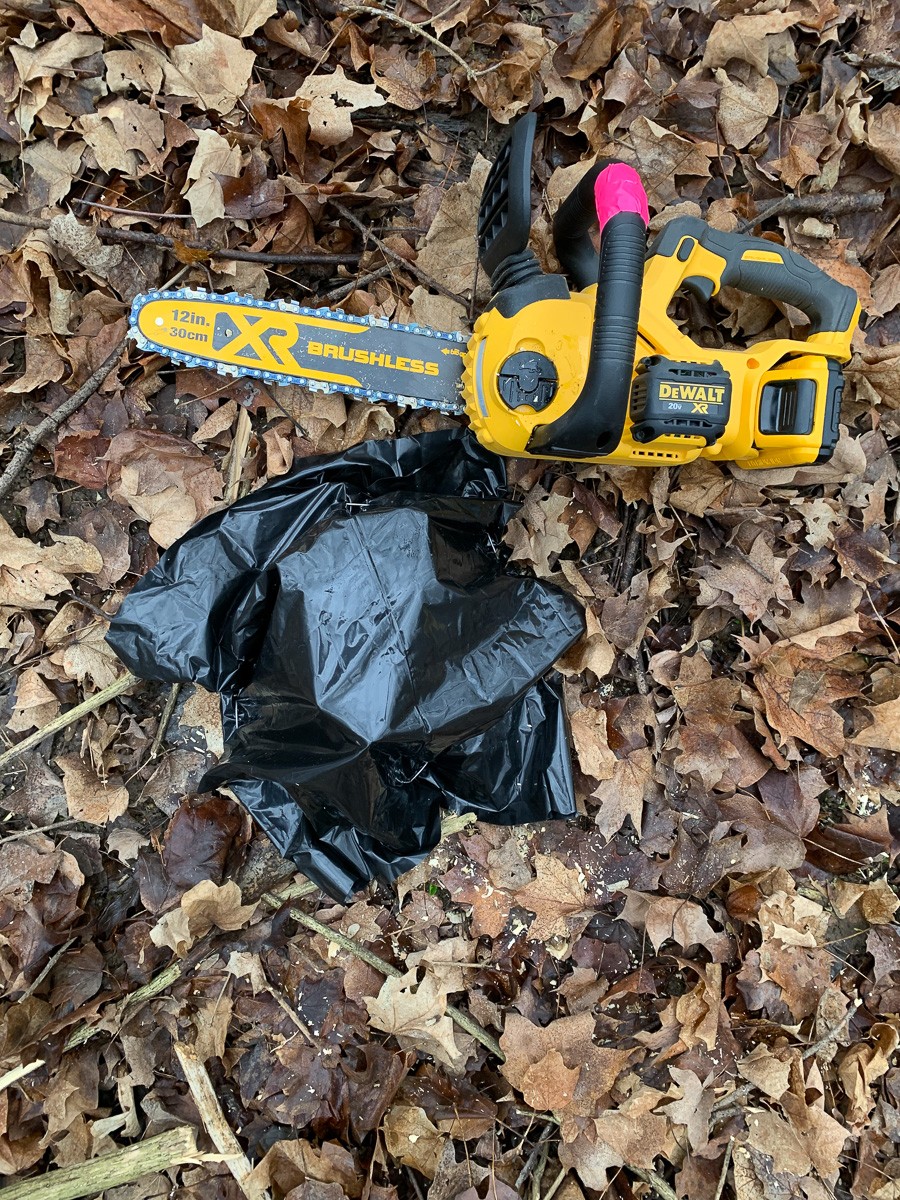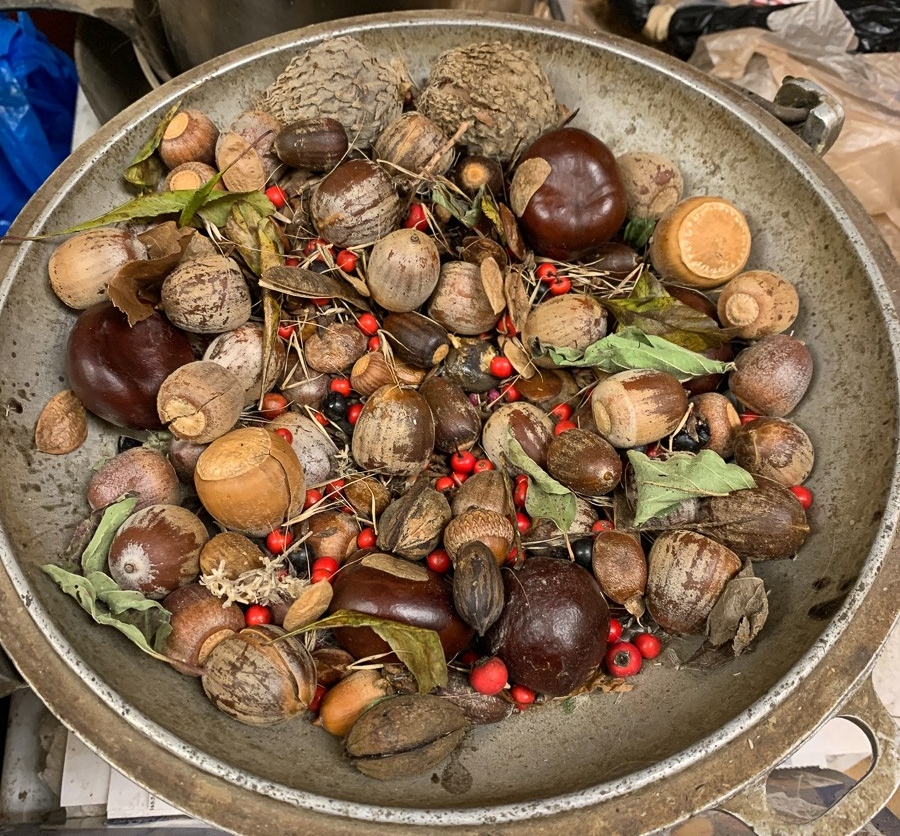
How to control honeysuckle without herbicides
UC botanist uses nontoxic way to kill invasive species
Amur honeysuckle is a common backyard pest in the eastern United States, where it crowds out most other plants.
University of Cincinnati botanist Denis Conover has been working to eradicate this invasive Asian shrub in parks and forests across Cincinnati. The bush’s thick roots grow deep and wide, making removal of an entire mature plant difficult. Foresters typically chainsaw the thick trunks of the bushes and apply toxic herbicide to the exposed surface.
But Conover has been experimenting with greener alternatives.
He has tried wrapping the trunk with different materials to block sunlight from the plant promoting new shoots. Now he is sharing his techniques with the public to help them safely remove the bushes from their own properties.

UC College of Arts and Sciences botanist Denis Conover uses a reciprocating saw to cut through the trunks of invasive Amur honeysuckle. Photo/Andrew Higley/UC Marketing + Brand
Conover appreciates how thoroughly honeysuckle has taken over many forests.
“It was introduced to North America more than 100 years ago as an ornamental but escaped cultivation,” he said. “It got into natural areas where it can totally take over.”
Nonnative plants have a history of escaping cultivation in the United States to create unexpected problems, Conover said. He points to introduced plant diseases such as chestnut blight and Dutch elm disease and insect pests such as hemlock woolly adelgid, which have devastated American forests.
Honeysuckle grows quickly, buds earlier and holds its leaves longer in the fall than other plants, shading out everything beneath it.
Eventually, you could have an entire monoculture of Amur honeysuckle where once there was a complex ecosystem of native deciduous forest.
Denis Conover, UC College of Arts and Sciences
Honeysuckle produces copious red berries that birds spread far and wide.
“Not very many caterpillars eat honeysuckle leaves. It’s a big pest. It can become so dense that not even tree seedlings can regenerate underneath it,” he said.
“So you might have some native trees poking up above the canopy. But once those trees die, that’s it. They’re not regenerating. Eventually, you could have an entire monoculture of Amur honeysuckle where once there was a complex ecosystem of native deciduous forest.”
In 1985, Conover and Donald Geiger, PhD, his mentor in the fields of plant physiology and ecological restoration, began removing Amur honeysuckle by applying herbicide to the cut stumps to prevent them from resprouting.
Tips to remove honeysuckle
- Cut the bush and any branch shoots low to the ground.
- Cover the stump and any exposed branch ends with garden plastic. Black garbage bags also work. Tie the plastic to the stump or secure it to the ground with garden wires.
- Plant native trees or bushes around the dead stump to discourage honeysuckle from returning.

Depriving a honeysuckle of sunlight will prevent new shoots from growing from its cut stump. Photo/Andrew Higley/UC Marketing + Brand
Recently, Conover has been working on honeysuckle eradication with Kate Nordyke, who owns nine acres of farmland and woods in the Cincinnati suburb of College Hill called the Evergreen Holistic Learning Center. The property has an organic garden, a horse barn and pasture surrounded by mature forest, including impressive 200-year-old beech trees.
“It’s an urban oasis. We are only 10 minutes from downtown, but you would never know it,” she said. “It’s a very special place.”
Nordyke earned degrees in biology and environmental studies at Miami University and the Union Institute and University. She and Conover worked on a botanical survey together at Spring Grove Cemetery & Arboretum. Plant specimens they collected were added to UC's Margaret H. Fulford Herbarium.
She hopes to get a conservation easement that will protect it in perpetuity. She said she wanted to be a good steward of her property. And that means addressing the invasive species that are crowding out the native plants.
“Managing invasives such as Amur honeysuckle was an important step in optimizing the ecological health of the forest,” she said. “So I felt it was an important area in which to invest time and energy.”
Nordyke doesn’t use herbicides on her property, which made it a good place to conduct experiments about the most effective nontoxic methods to kill invasive plants, Conover said.

UC botanist Denis Conover uses a chainsaw to cut through honeysuckle at ground level before covering the stump with black plastic secured from the wind with wire garden staples. Photo/Denis Conover
But removing honeysuckle is easier said than done, she said. Left to its devices, honeysuckle will resprout and grow wider and thicker than ever.
She sought advice from the Hamilton County Conservation District, which recommended covering the stumps to rob them of sunlight.
“For me, the main motivation for avoiding the use of herbicides is not wanting to put the health of myself or others at risk, including pets and wildlife,” she said.
Conover said he agrees that herbicides are overused.
“We don't really know the long-term effects of these chemicals on human health or the health of the environment,” he said.
Nordyke said some chemicals found in herbicides have been linked to cancer and can kill beneficial insects.
Conover is volunteering on Nordyke’s wooded property, experimenting with different ways of killing Amur honeysuckle and other alien plants without using herbicide. He has tried covering the stumps with different materials such as black weed control fabric, black plastic, clear plastic and even inverted black plastic flower pots. He anchors the plastic or fabric to the ground with wire garden staples.
Once the honeysuckle is gone, he plants native trees and shrubs in their place.
“These foreign plants contribute very little or nothing to the native forest ecosystem's food web and they displace the native plants which do contribute to the food web,” Conover said.

UC Educator Professor Denis Conover holds up an acorn. Oak trees provide habitat for countless species of wildlife, he said. Photo/Andrew Higley/UC Marketing + Brand
They found that simply covering the trunks in plastic such as black garbage bags and pinning it to the ground against the wind effectively kills honeysuckle without chemicals. Conover said the process is easy, effective and less expensive than herbicides, particularly since the materials can be reused.
“I tried the black plastic garbage bag method last summer on the stump of a large non-native, invasive mimosa tree that kept resprouting in my back yard. It worked,” Conover said.
His preferred method is to cut the stump at ground level and cover it with black plastic, secured to the ground with wire gardening staples.
“This elegant method is easy, effective and inexpensive. Sometimes I rake leaves over the plastic so you can’t even see it,” Conover said. “We immediately plant seeds or saplings of native trees and shrubs near the spot where the honeysuckle was cut down.”
In the past six months, Conover planted hundreds of acorns from several different species of native oak trees along with the seeds of other native trees and shrubs in Nordyke’s woods. The long list includes hickories, cherries, willows, dogwoods and hawthorns, among others, that provide food for native insects and birds.
Most native trees and shrubs can be grown easily from seed, Nordyke said.
“For every honeysuckle we cut down, we try to plant a native plant in its place,” Nordyke said. “I’ve had great success growing a variety of native plants from seeds.”
Cultivating native plants makes it less likely that honeysuckle will return, he said.
And the new plants will provide food for birds and other wildlife. Conover favors oak trees. Their leaves provide food for hundreds of species of caterpillars that birds depend on during nesting season.
“By removing the honeysuckle and replacing it with native trees and shrubs, there will certainly be a noticeable difference in the number of native caterpillars over the next few years, which will greatly benefit native birds,” Conover said.
Featured image at top: Amur honeysuckle. Photo/DipaliS/iStockPhoto

UC botanist Denis Conover plants a variety of native bushes and trees in place of the Amur honeysuckle he removes. Photo/Denis Conover
More UC Biology in the news
Next Lives Here
The University of Cincinnati is leading public urban universities into a new era of innovation and impact. Our faculty, staff and students are saving lives, changing outcomes and bending the future in our city's direction. Next Lives Here.
Related Stories
Senior peer career coaches graduate with resumes ready
April 17, 2021
Profiles three senior peer career coaches in the University of Cincinnati's Bearcat Promise Career Studio
UC students recognized for achievement in undergraduate research
April 12, 2021
Undergraduate student researchers in sciences and humanities recognized in 2021
UC students recognized for achievement in undergraduate research
April 29, 2020
Each spring, the University of Cincinnati’s Division of Experience-Based Learning and Career Education (ELCE) honors students in experience-based learning programs.
Listen: Cincy Playhouse shares CCM audio plays
May 28, 2021
Each audio play is its own story, and you can listen to these pieces for free in any order you choose. They represent a year-long collaboration that reached into many corners of Cincinnati. Students from all over UC (CCM Acting, Sound Design, Stage Management, Commercial Music Production, Digital Media, and the College of Arts & Sciences’ Fiction PhD program) and local professional writers (YA author Liz Coley and musician, comedian and raconteur Paul Strickland) came together to make something truly special. Paul Strickland's play will be available soon. The Playhouse is assisting CCM by hosting and helping to promote these free audio plays.
UC staff have elected their 2021-23 Staff Senators
June 8, 2021
Join us in congratulating the 2021-23 new Staff Senate members! Elections were held in early May, and new senators will begin their two-year term in July 2021. All UC staff are encouraged to be part of the enthusiasm and excitement for our new senators by attending the Staff Senate online meeting via WebEx, June 30, 9-11 a.m.
UC LGBTQ Center founder takes on new diversity role
June 1, 2021
When Leisan Smith, ’99, ME ’03, began work this year as the inaugural chief equity officer at the prestigious Columbus School for Girls, the school’s staff and faculty were thrilled. The job description, they said, “was written for you.”
The making of a successful Faculty & Staff Campaign
May 25, 2021
More than one-third of UC’s nearly 7,000 faculty and staff have already contributed to the 2020-21 Faculty & Staff Campaign, putting the goal of 45% within reach.
Engineering student shifts from the stage to the lab
May 14, 2021
Garek Bushnell came to the University of Cincinnati with a singular goal: to study acting. He graduated in April 2021 with his bachelor’s degree in chemical engineering instead. Bushnell’s path between these two seemingly dissimilar fields is rooted in his mindset that following your passion will drive your determination to succeed – even if that passion comes from an unexpected source.
UC Foundation Board of Trustees elects six new members
May 11, 2021
The University of Cincinnati Foundation Board of Trustees has elected six new trustees to its 52-member board: Paul D. Green, BBA ’90; Lourdes J. Harshe, BBA ’92; Anndréa M. Moore, BBA’10; Arun C. Murthy, BBA ’95; Kirk L. Perry, BBA ’90, HON ‘15; and Christopher J. Van Pelt, BA ’91, MA ’93.
UC Blue Ash student presents research at a major international conference
July 13, 2021
When Aqsa Raja began an undergraduate research project last spring as part of her Honors Program experience at the University of Cincinnati Blue Ash College, she never imagined it would lead to a presentation just a year later at a major international conference for microbiologists.
